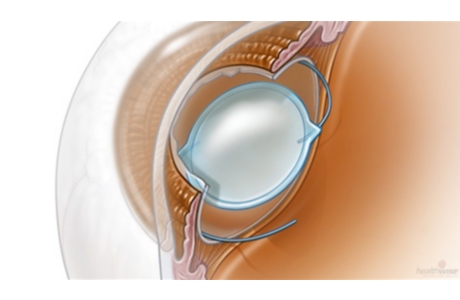Condition Basics
What are cataracts?
Cataracts are a painless, cloudy area in the lens of the eye. They block the passage of light to the retina. Nerve cells in the retina detect light entering the eye and send nerve signals to the brain about what the eye sees. Because cataracts block this light, they can cause vision problems.
Cataracts are common in older adults. But changes caused by aging don't always lead to cataracts. People with a family history of cataracts may also develop them. Sometimes children are born with cataracts.
What causes them?
Aging and exposure to sunlight can cause cataracts. But eye changes caused by aging don't always lead to cataracts. Cataracts can also happen after an eye injury, as a result of eye disease, after you use certain medicines, or as a result of health problems such as diabetes.
What are the symptoms?
Many times cataracts don't cause any vision problems. Symptoms can include cloudy, fuzzy, or foggy vision. You may have trouble driving at night because of glare from car headlights. The vision loss from a cataract often happens slowly. It may never become severe.
How are they diagnosed?
Your doctor can find out if you have cataracts by checking your eyes and by asking questions about your symptoms and past health. You may need tests to make sure you have a cataract or to rule out other conditions that may be causing vision problems.
How are cataracts treated?
Surgery is the only way to remove a cataract. The surgery works well and helps people see better. But surgery may not be needed or can be delayed for months or years. Many people with cataracts get along very well with the help of eyeglasses, contact lenses, and other vision aids.
Health Tools
Health Tools help you make wise health decisions or take action to improve your health.
What Increases Your Risk
Things that increase your risk for cataracts include:
- Older age.
- A family history of cataracts or certain genetic conditions.
- Diabetes. Persistent high blood sugar (glucose) levels can damage the lens of the eye.
- Surgery to treat glaucoma.
- Smoking. This can make chemicals called free radicals form. High levels of free radicals can damage cells, including those in the lens of the eye.
- Infection during pregnancy, such as rubella or chickenpox. These may cause the baby to develop a cataract before birth.
- Exposure to ultraviolet light.
- Long-term use of high doses of steroid medicines. These may be used for conditions such as asthma or emphysema.
Prevention
There is no proven way to prevent cataracts. But certain lifestyle habits may help slow cataract growth. These include:
- Not smoking.
- Wearing a hat or sunglasses when you are in the sun.
- Avoiding sunlamps and tanning booths.
- Eating healthy foods.
- Avoiding the use of steroid medicines when possible (some people need them).
- Keeping diabetes under control.
Symptoms
Cataracts can affect your vision in several ways.
- You may have cloudy, fuzzy, or foggy vision.
- You may see glare from lamps or the sun. You may have trouble driving at night because of glare from car headlights.
- You may need to change your eyeglasses prescription often.
The vision loss from a cataract often happens slowly. It may never become severe. Many times cataracts don't cause any vision problems.
What Happens
As a cataract progresses, more of the lens becomes cloudy. When the entire lens is white, it causes severe vision problems. Delaying surgery until this point isn't recommended.
Cataracts may stay small and you may not notice them. They often don't seriously affect vision. Many cataracts don't need to be removed.
Some cataracts grow larger or denser over time, causing severe vision changes.
- Decreased vision may affect driving, working, reading, or hobbies. This can cause a loss of independence.
- A rare type of cataract can lead to glaucoma.
If treatment is available, it's rare for cataracts to cause blindness. Surgery is usually done before this happens.
Cataracts in children are rare but serious. If a cataract prevents light from entering a child's eye, the area of the brain used for sight does not develop the right way. Unless it's treated right away, the child won't see well with that eye.
When to Call
Call your doctor now if you have:
- Severe eye pain.
- A sudden change in your vision, such as loss of vision or double vision.
Call your doctor to discuss your symptoms if you:
- Need frequent changes in your eyeglasses prescription.
- Have blurred or double vision that develops slowly.
- Are having a problem seeing during the daytime because of glare.
- Have trouble driving at night because of glare from headlights.
- Have vision problems that make it harder to do your daily activities.
If you are an older adult, discuss with your doctor how often you need to have routine eye exams.
Watchful waiting
Watchful waiting is a wait-and-see approach. Watchful waiting is safe and a good choice in most cases of adult cataracts. If you notice signs that your baby or child may not be seeing well, see your doctor. Cataracts in children should be treated right away.
Speak with an ophthalmologist about surgery to remove cataracts. In most cases, you can decide if you want or need surgery based on whether vision problems caused by the cataract are interfering with your daily activities.
Check your symptoms
Exams and Tests
Your doctor can find out if you have cataracts by checking your eyes. Your doctor will ask questions about your symptoms and past health. You may need tests to make sure you have a cataract. Tests can also rule out other conditions that may be causing vision problems.
During routine eye exams, your eye doctor will look for early signs of vision problems, including cataracts.
Treatment Overview
Surgery is the only way to remove a cataract. The surgery works well and helps people see better. But surgery may not be needed. Or it can be delayed for months or years. Many people with cataracts get along very well with the help of eyeglasses, contact lenses, and other vision aids.
Whether you need surgery depends on how much of a problem the cataract causes for daily activities like driving and reading. Surgery is almost always by your choice (elective). It can be scheduled when it's convenient.
Some people must have surgery. This includes children who are born with cataracts that need to be removed. It also includes people who get cataracts after an eye injury or as a result of eye disease or other health problems.
Only an ophthalmologist can treat cataracts.
Learn more
Self-Care
If you have cataracts, you can manage your vision problems at home and avoid or delay surgery. For example, you can:
- Use a soft background light plus a light on your task.
- Avoid glare on TV and computer screens. You can also move room lights and use window shades to avoid glare.
- Keep your eyeglass or contact lens prescription up to date.
- Wear sunglasses to block out harmful sunlight. Buy sunglasses that screen out ultraviolet A and B (UVA and UVB) rays.
- Use technology such as video enlargement systems or speech software for computer systems.
- Use a magnifying glass for reading. Look for large-print books. Use the settings on your phone, tablet, or other device to make the text size larger. These will make reading more enjoyable.
- Protect your eyes by avoiding falls. Adjust rugs, carpets, furniture, and electric cords to avoid tripping.
Explore more
Watch
Surgery
Surgery for cataracts involves removing the clouded lens of the eye (the cataract). The lens is most often replaced with an artificial lens called an intraocular lens implant (IOL).
If you don't have another eye condition, your chances of seeing better after cataract surgery are very good. But you may still need reading glasses or glasses for night driving.
Most adults who have surgery for cataracts do it to:
- Improve their vision.
- Help them return to work, hobbies, and other daily activities.
For most adults, surgery is only needed when vision loss caused by a cataract affects their quality of life.
There are several types of cataract surgery.
- Phacoemulsification (small-incision surgery with ultrasound). This is the most common method.
- Extracapsular cataract extraction (ECCE).
- Femtosecond laser-assisted cataract surgery (FLACS).
Learn more
Watch
Related Information
Credits
Current as of: June 5, 2023
Author: Healthwise Staff
Clinical Review Board
All Healthwise education is reviewed by a team that includes physicians, nurses, advanced practitioners, registered dieticians, and other healthcare professionals.
Current as of: June 5, 2023
Author: Healthwise Staff
Clinical Review Board
All Healthwise education is reviewed by a team that includes physicians, nurses, advanced practitioners, registered dieticians, and other healthcare professionals.





